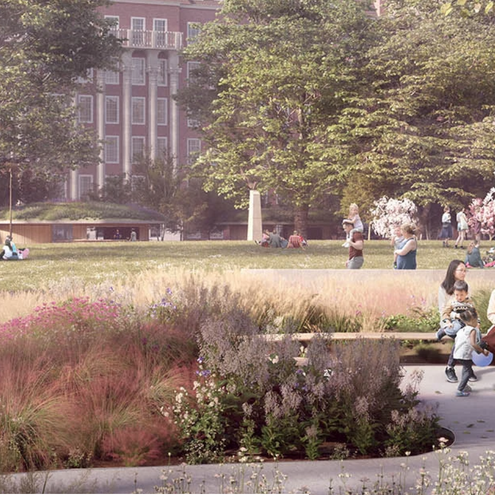Project showcase
Grosvenor Biodiversity Strategy, UK-wide – Grosvenor Property UK with Greengage Environmental

In 2022, Grosvenor developed a strategy with Greengage Environmental that sets evidence-based, measurable targets for the delivery of Biodiversity Net Gain across existing assets and future developments that go above and beyond compliance with emerging legislation. The strategy targets biodiversity uplifts on new and existing assets via Green Infrastructure retrofits, which the formal mandate will not cover.
Who is on the project team?
Greengage Environmental and Grosvenor Property UK.
Describe the context of this project and its neighbourhood and people?
To help it meet its aim of being a regenerative business by 2050, Grosvenor Property UK has committed to a holistic suite of stretching goals which redefine environmental action in the real estate sector.
In 2022, Grosvenor developed our Biodiversity Strategy; ‘Valuing Nature’, supported by Greengage. This presents a novel way in which nature-based retrofitting can be incentivised and approached in real estate. The strategy sets evidence-based, measurable targets for the delivery of Biodiversity Net Gain (BNG) across Grosvenor’s existing assets and future developments, that go above and beyond compliance with emerging legislation. The strategy targets BNG uplifts on new and existing assets via Green Infrastructure (GI) retrofits, which the formal mandate for BNG will not cover.
The delivery of BNG via the implementation of GI/NbS provides a wide range of social/community benefits, particularly where assets are publicly accessible. A case study included within the strategy is the work planned at Grosvenor Square, which will see the transformation of London’s 2nd largest garden square to enhance biodiversity, water management, and community engagement with school and community learning initiatives to be held in the transformed gardens.
The strategy will support the delivery of nature-positive enhancements across the whole of Grosvenor’s UK property portfolio, which includes buildings and neighbourhoods across the UK. The strategy not only supports positive behavioural change within the organisation itself, but also across its entire portfolio, delivering benefits to all those who lease, inhabit, work in, or use the spaces.
What is your design approach?
Most of the buildings that will be standing in the UK by the mid-21st century, already exist. The biggest piece in the climate adaptation puzzle is the retrofitting of existing assets, though appetite for this remains low. Grosvenor’s Biodiversity Strategy presents a novel way of incentivising the enhancement of existing assets, through the establishment and delivery of BNG targets, against which performance can be monitored, evaluated, and disclosed within corporate reporting. The targets are established upon a baseline assessment of Grosvenor’s existing portfolio, undertaken using the Defra Metric. The targets are therefore evidence-based, with the precise uplifts defined through collaboration with Grosvenor. These targets are included in our overall business and individual objectives – influencing remuneration across the business.
Ultimately, Grosvenor & Greengage views biodiversity as the (increasingly measurable) conduit through which the multifunctional values of nature can be delivered. These range from environmental/climatic, to social, and even economic and financial benefits. Responding to the climate emergency is central to the strategy and delivering multifunctional GI provides a means of delivering these wider environmental co-benefits or ‘Environmental Net Gain’ (ENG).
What is your climate strategy?
The core purpose and function of Grosvenor’s Biodiversity Strategy is to support nature’s recovery and enhance biodiversity across its urban, strategic land, and office and residential holdings and developments.
The strategy is supported by a ‘Biodiversity Buffet’, prepared by Greengage, which provides guidance on how to deliver the net gains in practice. The Buffet details a range of GI/NbS with accompanying design guidance for new development and retrofit projects. The strategy has been used to position biodiversity at the forefront of development considerations and management of Grosvenor’s assets, and annual progress against quantifiable targets is monitored.
The strategy and ‘Buffet’ consider climate resilience, connectivity, sustainable material use, and horticultural best practice in design to ensure benefits to nature/biodiversity are maximised and appropriate. The strategy considers both BNG and wider ENG, ensuring that the quality and quantity of habitats are enhanced, whilst simultaneously delivering wider co-benefits, such as flood risk mitigation, temperature regulation, air quality improvement, and health and wellbeing benefits amongst others.
The strategy is grounded in the principle of BNG and considers the emergent concept of ENG. The science-based assessment, evidence-based target setting, ongoing monitoring, and reporting methodology also aligns with the recommendations of the Taskforce on Nature-related Financial Disclosures (TNFD). The strategy advocates for the prioritisation of a range of NbS, as does the TNFD. The progress tracking ensures that internal stakeholders are bought in to the ambition of the strategy and facilitates communication of progress to external stakeholders as well.
How have you engaged the community?
Setting corporate biodiversity targets supports positive behavioural change within organisations, such as GPUK. In addition, successfully embedding nature-positive ambitions within such corporate strategies will act as a catalyst for other real estate stakeholders to follow suit. Developers, asset owners, and asset managers are incredibly influential stakeholders, who can shape the nature and future of our built environment. Ensuring their ‘buy-in’ to addressing the climate and ecological crises is essential to delivering a climate resilient, liveable, and sustainable future. Strategies such as GPUK’s are a means of ensuring these stakeholders are bought in and are held to account to deliver wider social value.
The strategy also sought to strengthen peoples’ connections with nature to provide health and wellbeing co-benefits (see Trumpington Meadows case study). Fundamentally, the strategy sought to exceed best practice in all aspects and enhance the quality and quantity of biodiverse habitats for the benefit of both priority species and people.
Festival of Pineapples
24-26 February 2026
Pineapples prize giving night
April
Pineapples at Festival of Place
10 June 2026
© The Pineapples - Tweak Ltd. 124 City Road, London, EC1V 2NX. Tel: 020 3326 7238




